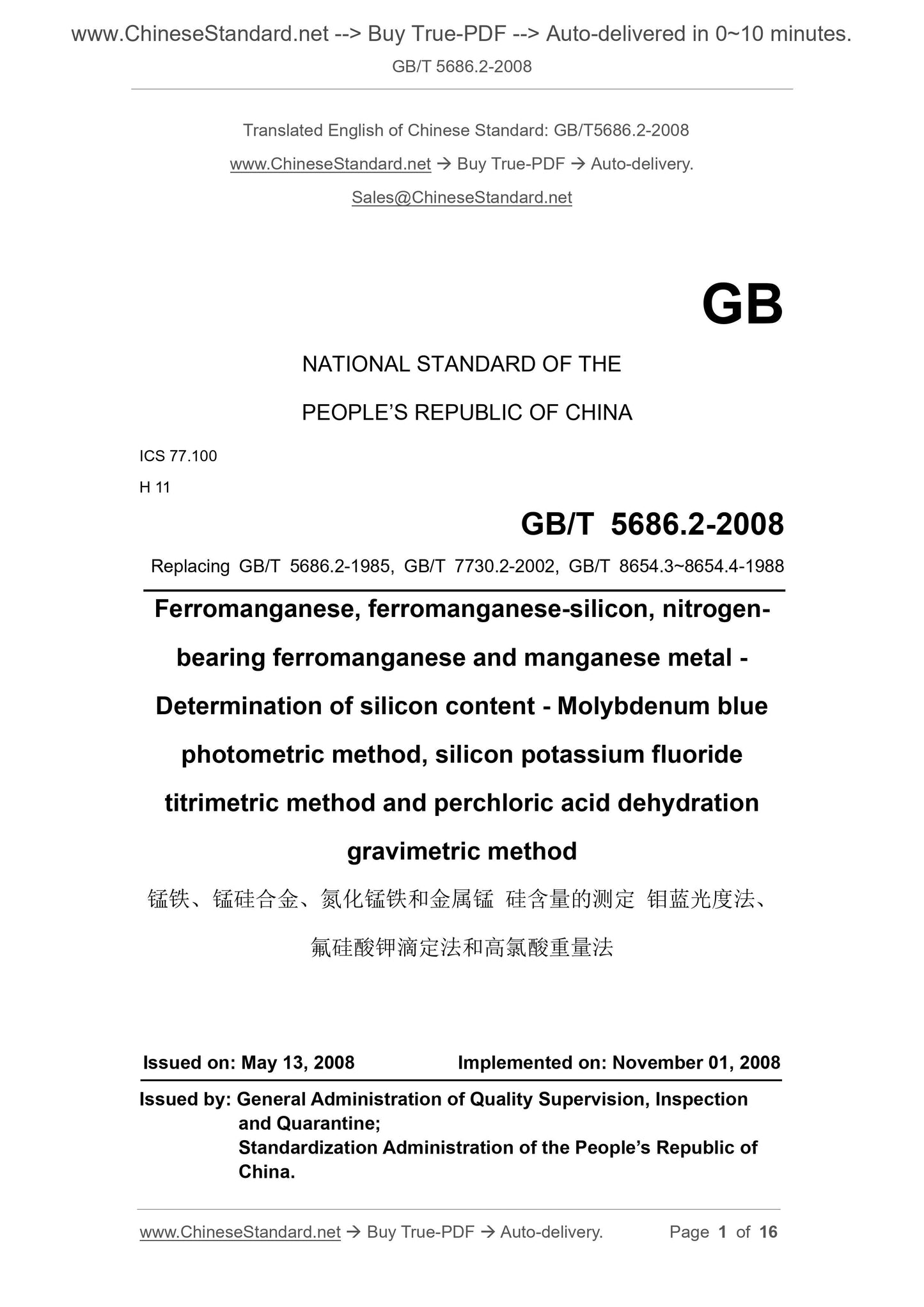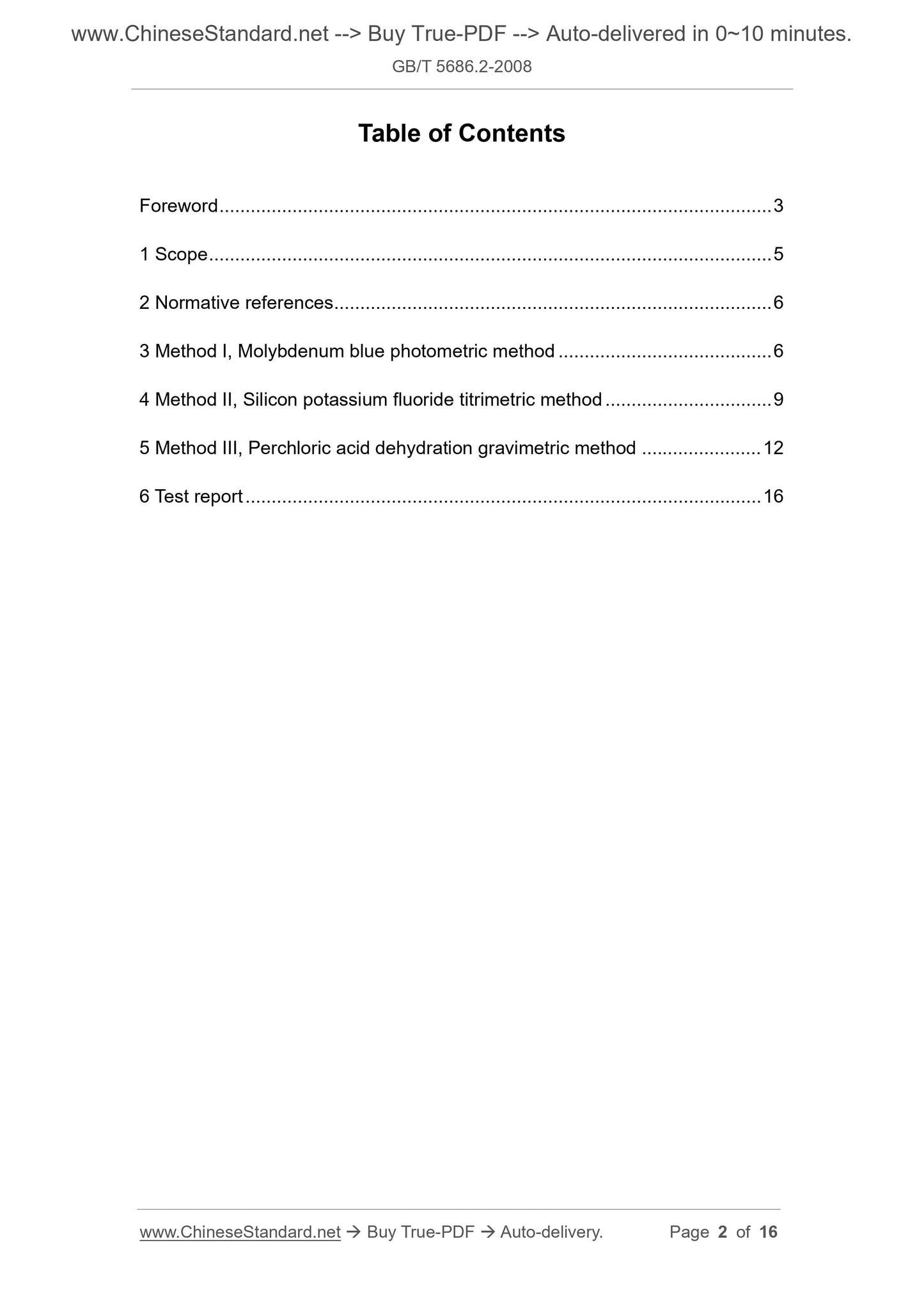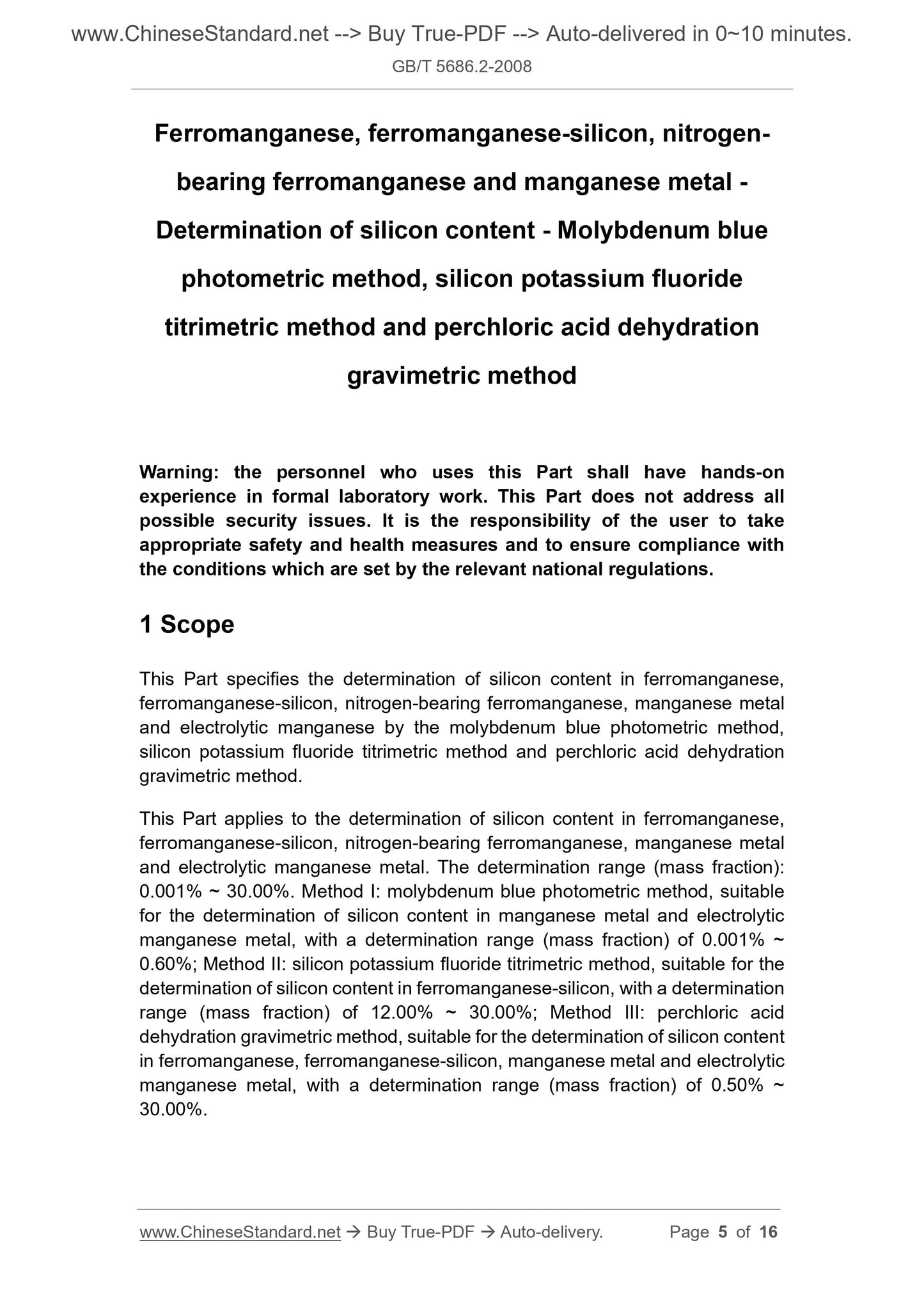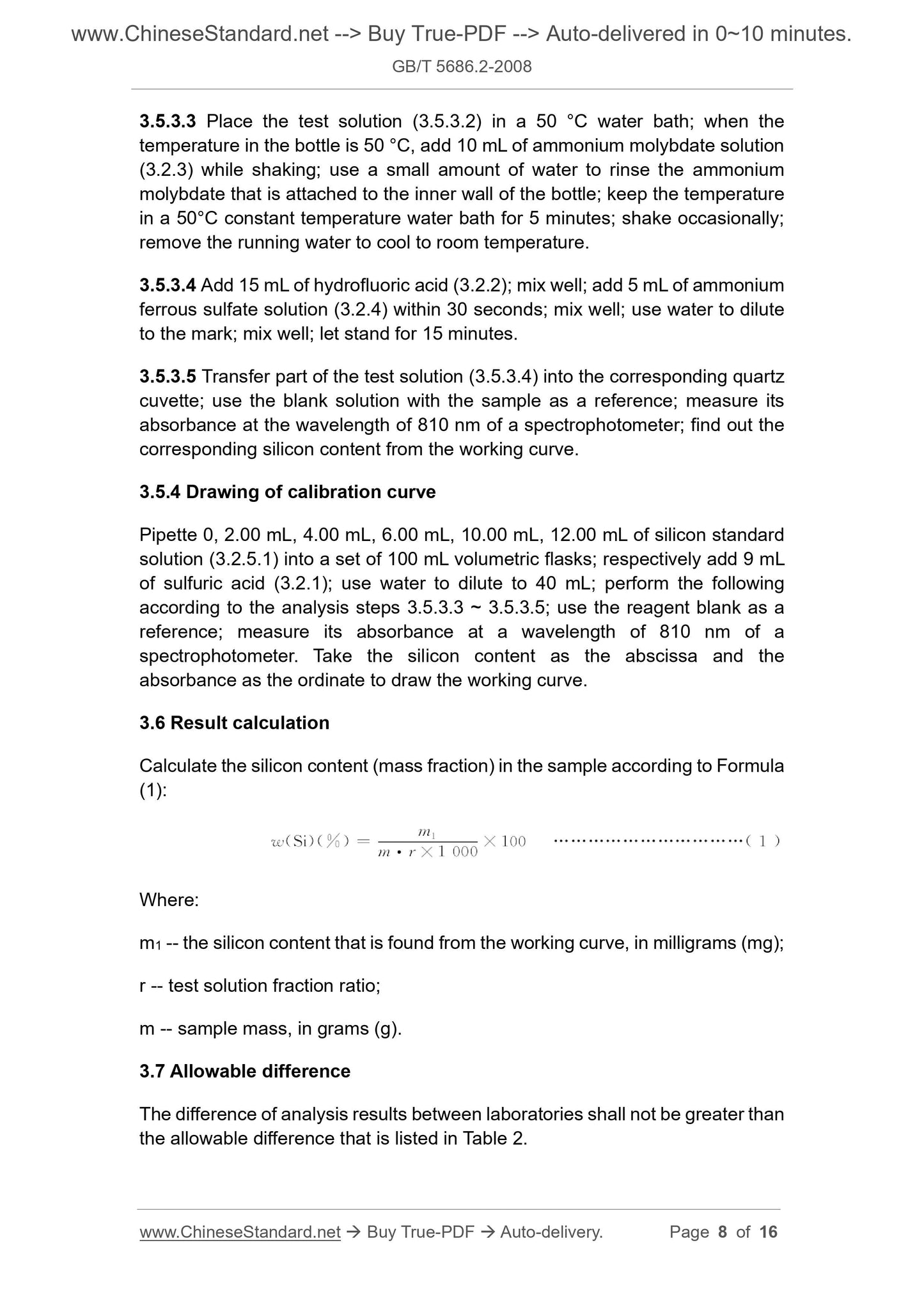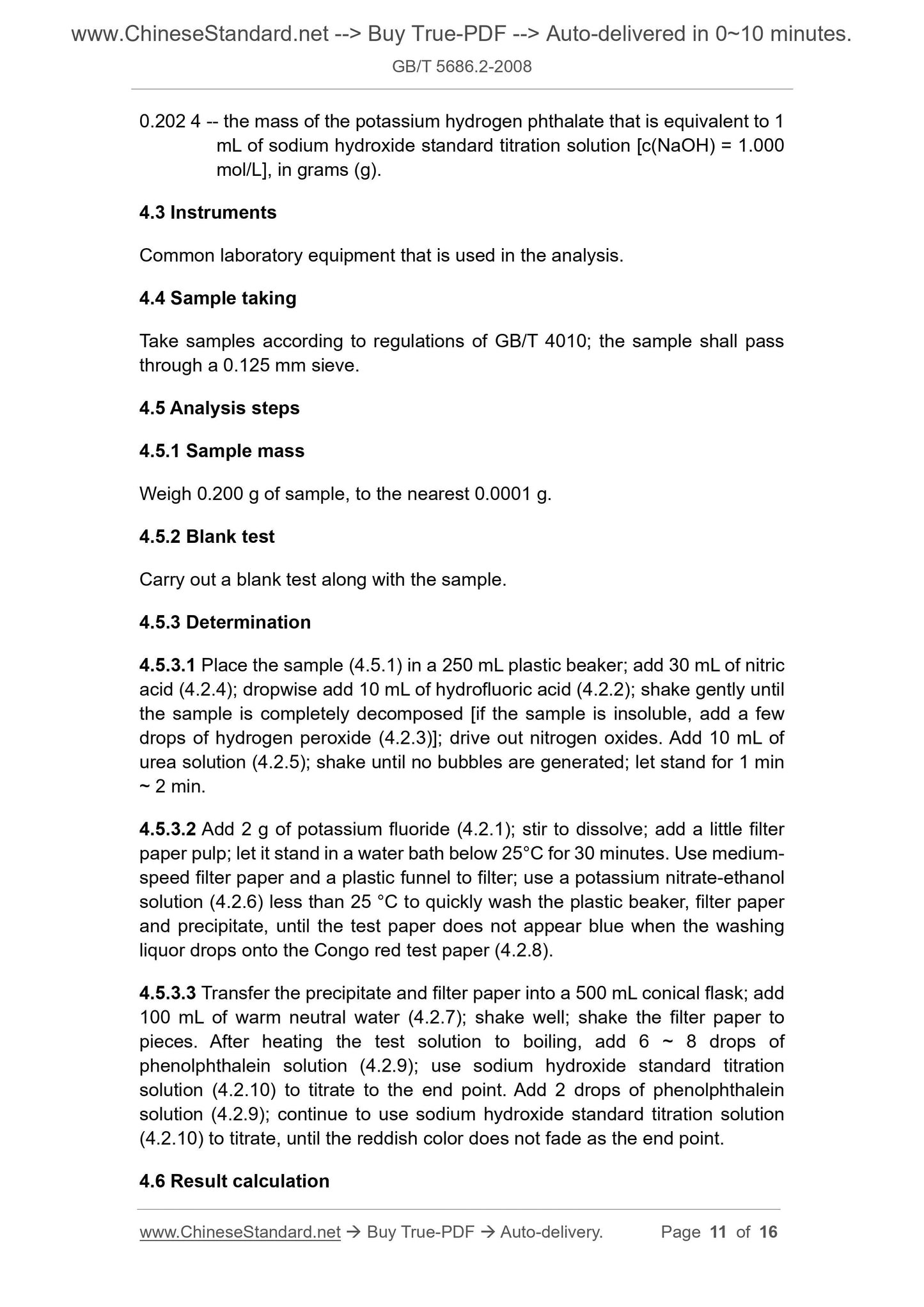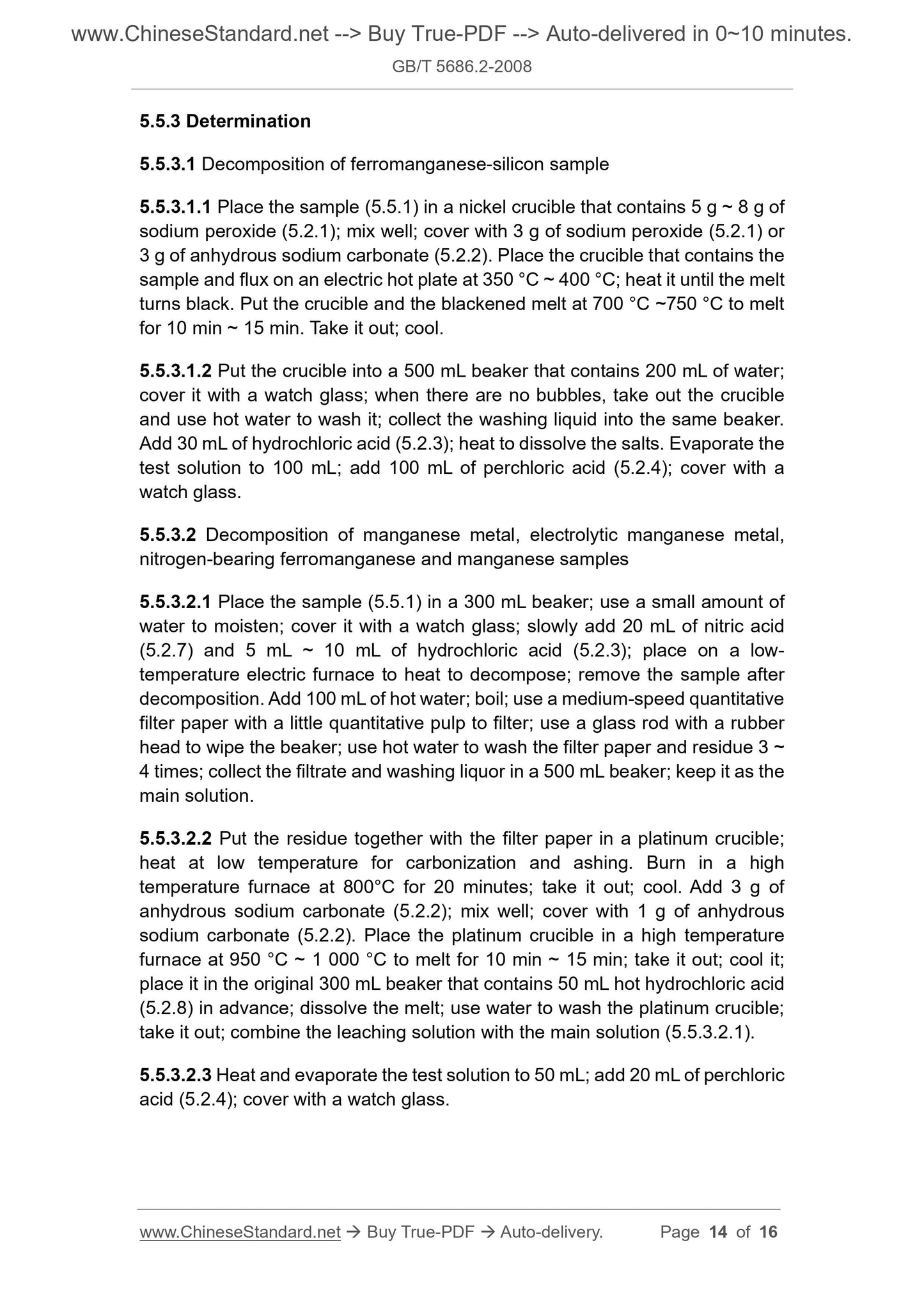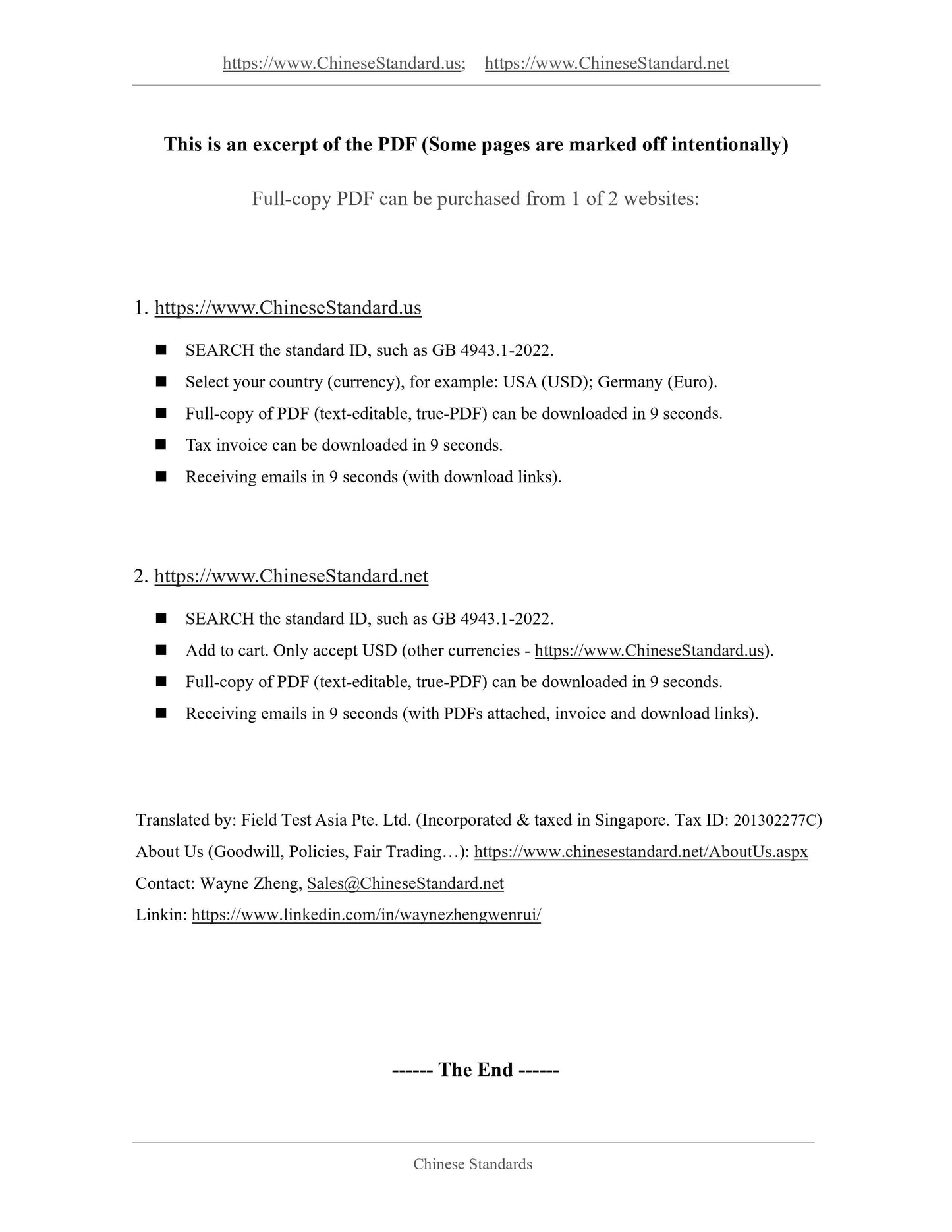1
/
of
7
PayPal, credit cards. Download editable-PDF and invoice in 1 second!
GB/T 5686.2-2008 English PDF (GB/T5686.2-2008)
GB/T 5686.2-2008 English PDF (GB/T5686.2-2008)
Regular price
$145.00
Regular price
Sale price
$145.00
Unit price
/
per
Shipping calculated at checkout.
Couldn't load pickup availability
GB/T 5686.2-2008: Ferromanganese, ferromanganese-silicon, nitrogen-bearing ferromanganese and manganese metal -- Determination of silicon content -- Molybdenum blue photometric method, silicon potassium fluoride titrimetric method and perchloric acid dehydration gravimetri
Delivery: 9 seconds. Download (and Email) true-PDF + Invoice.Get Quotation: Click GB/T 5686.2-2008 (Self-service in 1-minute)
Newer / historical versions: GB/T 5686.2-2008
Preview True-PDF
Scope
This Part specifies the determination of silicon content in ferromanganese,ferromanganese-silicon, nitrogen-bearing ferromanganese, manganese metal
and electrolytic manganese by the molybdenum blue photometric method,
silicon potassium fluoride titrimetric method and perchloric acid dehydration
gravimetric method.
This Part applies to the determination of silicon content in ferromanganese,
ferromanganese-silicon, nitrogen-bearing ferromanganese, manganese metal
and electrolytic manganese metal. The determination range (mass fraction):
0.001% ~ 30.00%. Method I: molybdenum blue photometric method, suitable
for the determination of silicon content in manganese metal and electrolytic
manganese metal, with a determination range (mass fraction) of 0.001% ~
0.60%; Method II: silicon potassium fluoride titrimetric method, suitable for the
determination of silicon content in ferromanganese-silicon, with a determination
range (mass fraction) of 12.00% ~ 30.00%; Method III: perchloric acid
dehydration gravimetric method, suitable for the determination of silicon content
in ferromanganese, ferromanganese-silicon, manganese metal and electrolytic
manganese metal, with a determination range (mass fraction) of 0.50% ~
30.00%.
3.5.3.3 Place the test solution (3.5.3.2) in a 50 °C water bath; when the
temperature in the bottle is 50 °C, add 10 mL of ammonium molybdate solution
(3.2.3) while shaking; use a small amount of water to rinse the ammonium
molybdate that is attached to the inner wall of the bottle; keep the temperature
in a 50°C constant temperature water bath for 5 minutes; shake occasionally;
remove the running water to cool to room temperature.
3.5.3.4 Add 15 mL of hydrofluoric acid (3.2.2); mix well; add 5 mL of ammonium
ferrous sulfate solution (3.2.4) within 30 seconds; mix well; use water to dilute
to the mark; mix well; let stand for 15 minutes.
3.5.3.5 Transfer part of the test solution (3.5.3.4) into the corresponding quartz
cuvette; use the blank solution with the sample as a reference; measure its
absorbance at the wavelength of 810 nm of a spectrophotometer; find out the
corresponding silicon content from the working curve.
3.5.4 Drawing of calibration curve
Pipette 0, 2.00 mL, 4.00 mL, 6.00 mL, 10.00 mL, 12.00 mL of silicon standard
solution (3.2.5.1) into a set of 100 mL volumetric flasks; respectively add 9 mL
of sulfuric acid (3.2.1); use water to dilute to 40 mL; perform the following
according to the analysis steps 3.5.3.3 ~ 3.5.3.5; use the reagent blank as a
reference; measure its absorbance at a wavelength of 810 nm of a
spectrophotometer. Take the silicon content as the abscissa and the
absorbance as the ordinate to draw the working curve.
3.6 Result calculation
Calculate the silicon content (mass fraction) in the sample according to Formula
(1):
Where:
m1 -- the silicon content that is found from the working curve, in milligrams (mg);
r -- test solution fraction ratio;
m -- sample mass, in grams (g).
3.7 Allowable difference
The difference of analysis results between laboratories shall not be greater than
the allowable difference that is listed in Table 2.
0.202 4 -- the mass of the potassium hydrogen phthalate that is equivalent to 1
mL of sodium hydroxide standard titration solution [c(NaOH) = 1.000
mol/L], in grams (g).
4.3 Instruments
Common laboratory equipment that is used in the analysis.
4.4 Sample taking
Take samples according to regulations of GB/T 4010; the sample shall pass
through a 0.125 mm sieve.
4.5 Analysis steps
4.5.1 Sample mass
Weigh 0.200 g of sample, to the nearest 0.0001 g.
4.5.2 Blank test
Carry out a blank test along with the sample.
4.5.3 Determination
4.5.3.1 Place the sample (4.5.1) in a 250 mL plastic beaker; add 30 mL of nitric
acid (4.2.4); dropwise add 10 mL of hydrofluoric acid (4.2.2); shake gently until
the sample is completely decomposed [if the sample is insoluble, add a few
drops of hydrogen peroxide (4.2.3)]; drive out nitrogen oxides. Add 10 mL of
urea solution (4.2.5); shake until no bubbles are generated; let stand for 1 min
~ 2 min.
4.5.3.2 Add 2 g of potassium fluoride (4.2.1); stir to dissolve; add a little filter
paper pulp; let it stand in a water bath below 25°C for 30 minutes. Use medium-
speed filter paper and a plastic funnel to filter; use a potassium nitrate-ethanol
solution (4.2.6) less than 25 °C to quickly wash the plastic beaker, filter paper
and precipitate, until the test paper does not appear blue when the washing
liquor drops onto the Congo red test paper (4.2.8).
4.5.3.3 Transfer the precipitate and filter paper into a 500 mL conical flask; add
100 mL of warm neutral water (4.2.7); shake well; shake the filter paper to
pieces. After heating the test solution to boiling, add 6 ~ 8 drops of
phenolphthalein solution (4.2.9); use sodium hydroxide standard titration
solution (4.2.10) to titrate to the end point. Add 2 drops of phenolphthalein
solution (4.2.9); continue to use sodium hydroxide standard titration solution
(4.2.10) to titrate, until the reddish color does not fade as the end point.
4.6 Result calculation
5.5.3 Determination
5.5.3.1 Decomposition of ferromanganese-silicon sample
5.5.3.1.1 Place the sample (5.5.1) in a nickel crucible that contains 5 g ~ 8 g of
sodium peroxide (5.2.1); mix well; cover with 3 g of sodium peroxide (5.2.1) or
3 g of anhydrous sodium carbonate (5.2.2). Place the crucible that contains the
sample and flux on an electric hot plate at 350 °C ~ 400 °C; heat it until the melt
turns black. Put the crucible and the blackened melt at 700 °C ~750 °C to melt
for 10 min ~ 15 min. Take it out; cool.
5.5.3.1.2 Put the crucible into a 500 mL beaker that contains 200 mL of water;
cover it with a watch glass; when there are no bubbles, take out the crucible
and use hot water to wash it; collect the washing liquid into the same beaker.
Add 30 mL of hydrochloric acid (5.2.3); heat to dissolve the salts. Evaporate the
test solution to 100 mL; add 100 mL of perchloric acid (5.2.4); cover with a
watch glass.
5.5.3.2 Decomposition of manganese metal, electrolytic manganese metal,
nitrogen-bearing ferromanganese and manganese samples
5.5.3.2.1 Place the sample (5.5.1) in a 300 mL beaker; use a small amount of
water to moisten; cover it with a watch glass; slowly add 20 mL of nitric acid
(5.2.7) and 5 mL ~ 10 mL of hydrochloric acid (5.2.3); place on a low-
temperature electric furnace to heat to decompose; remove the sample after
decomposition. Add 100 mL of hot water; boil; use a medium-speed quantitative
filter paper with a little quantitative pulp to filter; use a glass rod with a rubber
head to wipe the beaker; use hot water to wash the filter paper and residue 3 ~
4 times; collect the filtrate and washing liquor in a 500 mL beaker; keep it as the
main solution.
5.5.3.2.2 Put the residue together with the filter paper in a platinum crucible;
heat at low temperature for carbonization and ashing. Burn in a high
temperature furnace at 800°C for 20 minutes; take it out; cool. Add 3 g of
anhydrous sodium carbonate (5.2.2); mix well; cover with 1 g of anhydrous
sodium carbonate (5.2.2). Place the platinum crucible in a high temperature
furnace at 950 °C ~ 1 000 °C to melt for 10 min ~ 15 min; take it out; cool it;
place it in the original 300 mL beaker that contains 50 mL hot hydrochloric acid
(5.2.8) in advance; dissolve the melt; use water to wash the platinum crucible;
take it out; combine the leaching solution with the main solution (5.5.3.2.1).
5.5.3.2.3 Heat and evaporate the test solution to 50 mL; add 20 mL of perchloric
acid (5.2.4); cover with a watch glass.
Basic Data
| Standard ID | GB/T 5686.2-2008 (GB/T5686.2-2008) |
| Description (Translated English) | Ferromanganese, ferromanganese-silicon, nitrogen-bearing ferromanganese and manganese metal -- Determination of silicon content -- Molybdenum blue photometric method, silicon potassium fluoride titrimetric method and perchloric acid dehydration gravimetri |
| Sector / Industry | National Standard (Recommended) |
| Classification of Chinese Standard | H11 |
| Classification of International Standard | 77.100 |
| Word Count Estimation | 10,139 |
| Date of Issue | 2008-05-13 |
| Date of Implementation | 2008-11-01 |
| Older Standard (superseded by this standard) | GB/T 5686.2-1985; GB/T 7730.2-2002; GB/T 8654.3-1988; GB/T 8654.4-1988 |
| Quoted Standard | GB/T 4010 |
| Regulation (derived from) | National Standard Approval Announcement 2008 No.8 (Total No.121) |
| Issuing agency(ies) | General Administration of Quality Supervision, Inspection and Quarantine of the People's Republic of China, Standardization Administration of the People's Republic of China |
| Summary | This standard specifies the use of molybdenum blue spectrophotometry, determination of ferromanganese silicon potassium fluoride and perchloric acid titration gravimetric method, nitrided ferromanganese, , manganese metal and manganese silicon manganese silicon alloy. This section applies to ferromanganese, determination and electrolytic manganese metal manganese silicon content, manganese silicon alloy, nitrided ferromanganese. Measuring range (mass fraction): 0. 001% to 30. 00%. Method One: molybdenum blue method. EMM for the determination of manganese metal and silicon content. Measuring range (mass fraction) from 0. 001% to 0. 60%, Method Two |
Share
